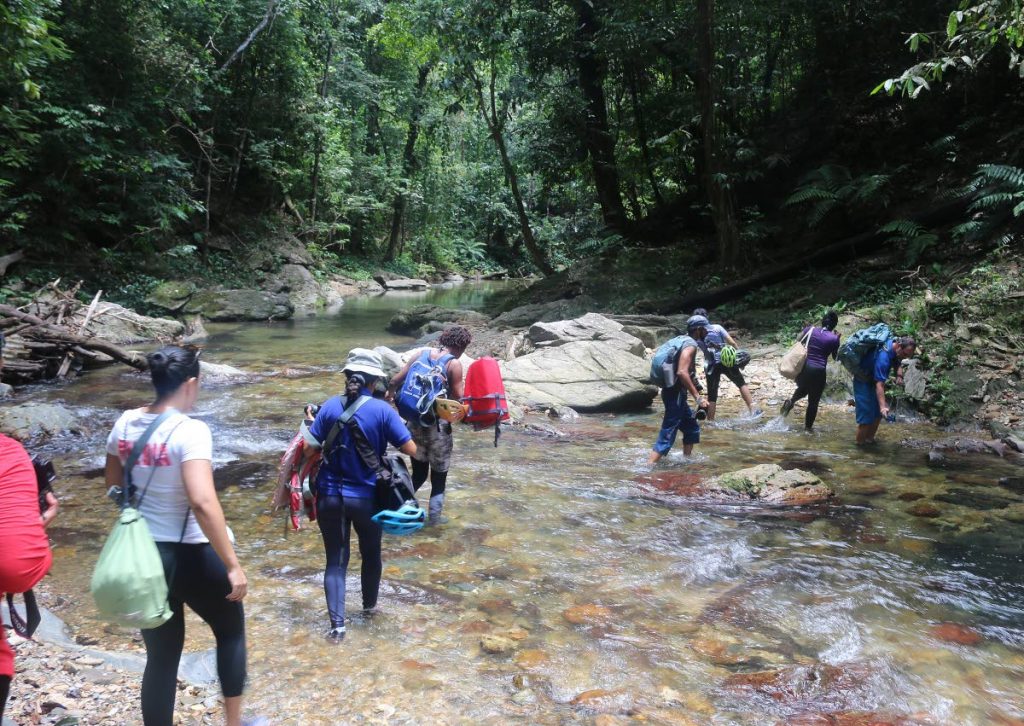Hiking with caution

WITH the rainy season upon us, individual hikers and hiking clubs need to be even more careful when heading into the forested areas of TT.
Michael Jattan, secretary of the Hiking Association of TT, said there are certain guidelines that hikers should follow, and things they should ask of a hiking club for their own safety.
The first and most important advice is to monitor the weather reports in the days before the hike.
He said if there was a weather alert, storm watch, or heavy rainfall pattern up to two days before, it was a good idea to postpone or cancel.
He said while the weather on the day of the hike may be fine, days of continuous or heavy rainfall could lead to swollen or rushing rivers, saturated soil leading to landslips and other dangers.
He said while the main responsibility was on the hike organiser, hikers too should pay attention to the rainfall pattern. In fact, he said, it was a good practice to call the area’s police station or someone living in the area to ask what the weather was like over the past few days.
This was because often one area of the country was sunny while another was not.
Jattan advised hikers to ask organisers if they were familiar with the trail, if they had life jackets for everyone in the group, if they were first-aid certified, and if security would be provided for parked vehicles.
New hikers should consider starting on a hike rated easy to moderate.
“For persons who are new to hiking, even if they are going to the gym, you don’t want to assume that because of that you are super fit. Hike fitness and gym fitness are two different things.”
Footwear with a good grip was also important for two reasons – venomous snakes and footing. Proper hiking boots, running shoes, or shoes made especially for outdoor use are recommended.
He recommend not carrying babes in arms, instead waiting until the child is about five years old and to only carry them on easy hikes.
He also said although the end point may be a body of water, a hike was not a river lime. He therefore advised against drinking alcohol as it impairs motor skills and could lead to slips, falls, and difficulties in the water.
Since the association’s inauguration last year its members started formulating standards derived from best practices abroad. Jattan said they intended to publish and distribute four booklets in the next few months for the benefit of hikers and hiking clubs.
“We think, to a large extent, people are ignorant of the risks they can potentially face when they go on a trail. We want people to have fun but we also want them to be mindful that once you enter any forested area in TT, you run risks and you want to reduce the risks as much as possible.”
He hoped providing the booklets would reduce the number of negative incidences.
One of group’s hike leaders, Michael Charlerie, said his club has similar guidelines. He told Newsday the club rated all hikes with one to four for the average hiker, five to seven is strenuous, and eight to ten, a challenging hike.
Before each hike they determine what kind of exercise a person does and, if it is only the gym, they are informed that hiking was a very different kind of exercise and suggests that they start on an easier rated hike. “If someone new comes we ask around to find out who exercises. According to the hike rating, if someone doesn’t exercise, or the kind of exercise doesn’t match with the terrain, we usually tell them to go back home.”
Charlerie said the club usually provides life jackets to everyone in the group;
they always have rope to help river or pool crossings and as hand-holds on inclines;
they are very careful about crossing rivers, especially if the current seemed to be strong;
in case of emergencies, hike leaders always carry cell phones in waterproof bags since there are a lot of areas in the forests that have cell phone signal; and
all hike leaders carry first-aid kits as they have first aid and pool rescuing training.
In addition, he said, at least two hike leaders are positioned at the back of the group to ensure no one was left behind. He explained that stronger hikers often set a faster pace so the group tended to separate into smaller groups at the front, in the middle and at the back with stragglers in between. He advised hikers to stay with one of these sub groups.
He said certain parts of tails are narrow and winding so hikers could only walk in single-file and the hike leaders would not be able to see everyone. Therefore, he suggests a buddy system so specific people could look out for each other.
Despite these precautions, individuals could be separated from the overall group if they, for example, step off the trail to take pictures or to urinate, and may be left behind. He advises the separated individual, if they were not an experienced hiker and did not know the trail, to “stand their ground.”
“There would either be a hike leader behind or their buddy should realise that they are not within the group and inform a hike leader. Even if that doesn’t happen, the hike leaders always conduct a headcount at the end of the hike to ensure everyone was accounted for. Someone will go back for them.”


Comments
"Hiking with caution"